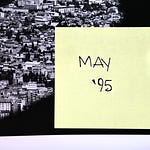July 1994.
As predicted by the Serbian President, Slobodan Milošević, the Contact Group Plan for peace in Bosnia and Herzegovina is opposed by the President of Republika Srpska, Radovan Karadžić [you can listen to the latest episode of BarBalkans - Podcast here].
However, the more Karadžić tries to distance himself from Milošević, the more he hampers the Serbian leader’s efforts to have the international community lift sanctions against the entire Federal Republic of Yugoslavia, and to pursue the goal of “Greater Serbia” step by step.
To the point of threatening a regional war in Serbia, Montenegro, Kosovo and Bosnia and Herzegovina, «if the maps are not corrected» by the Contact Group.
Chaos over the Peace Plan maps
On July 5, in Geneva, the Contact Group (formed by the United States, Russia, France, the United Kingdom and Germany) publishes the official maps of the new division of Bosnia and Herzegovina, in line with the first draft dated May 13.
The Contact Group Plan takes inspiration from the Juppé-Kinkel Plan of November 1993, with a division in two parts (instead of three): 51% to the new Federation between Bosnian Croats and Bosniaks, and 49% to Bosnian Serbs.
Bosnian Serbs must cede 22% of the territory currently controlled in Bosnia and Herzegovina, while the enclaves of Srebrenica, Žepa and Goražde are assigned to the Federation. Sarajevo will be a United Nations protectorate for two years, while Mostar will be a European Union protectorate.
The Plan is presented as «the last offer of the international community», to be accepted or rejected by July 19. In case of opposition, economic sanctions will be introduced or tightened, if they already exist.

However, the Contact Group Plan has significant deficiencies. For example, the threats on sanctions are vague, and there is no consensus among the allies on the enforcement.
While the solution may work for the Bosnian Croats (90% of ethnic Croats in the Republic would live within the same borders), the same cannot be said for the Bosniaks. They complain about the absence of references to refugee return, punishment for war criminals, and the misappropriation of 7% of territory.
«Provided that Bosnia and Herzegovina remains a single State within its internationally recognized borders», in the end they also give the green light. This is because rejecting the Plan would have worse consequences, and because everyone knows that the Bosnian Serb block is virtually unwavering.
And in fact, here Karadžić comes, despite his written commitment with Milošević in Belgrade not to oppose the peace plan. Upon returning to Pale, the President of Republika Srpska himself urges the members of the Bosnian Serb Parliament to reject the proposal. This stance is backed by the Orthodox Church and the Army General Staff of the Federal Republic of Yugoslavia.
On July 19, the last day to communicate the decision to the Contact Group, the Bosnian Serb Parliament approves the Plan but with 6 conditions:
Clarifications on Bosnia and Herzegovina’s constitutional order;
Changes to the conditions for the cease-fire;
Access to the sea for Republika Srpska;
Subdivision of Sarajevo administration;
Quick arrangements for lifting sanctions;
International recognition of Republika Srpska.
For the Bosnian Serb political establishment, the Contact Group Plan is nothing more than a starting point for new negotiations, not a finish line.
The U.S. and German diplomats consider the response a rejection in substance, whereas the French, British and Russians see it as an opening, that should not be jeopardized by new sanctions on the Federal Republic of Yugoslavia.
Therefore, it is decided in Geneva to postpone the deadline another 10 days, to coordinate partners and hope for a softening of Karadžić’ position.
Both hopes fail.
When the Contact Group reconvenes on July 30, there is no shared conclusion. The five governments only agree on a statement granting additional time to decide whether to accept or reject the Plan. Instead, the decision on whether to tighten international sanctions against Belgrade (in place since May 1992) will be up to the UN Security Council.

Armed and verbal counteroffensives
While the latest desperate attempt to achieve peace through diplomacy is ongoing at the negotiating tables, the war in Bosnia and Herzegovina continues day after day.
The total number of casualties in Sarajevo reaches 10,000 since the siege began in April 1992. But since the peace between Croatia and Bosnia and Herzegovina and the birth of the new Federation, the Bosniak and Bosnian Croat armed forces have begun to cooperate structurally to break the territorial continuity between Serb conquests in the north and east of the country.
This allows the Army of the Republic of Bosnia and Herzegovina to reorganize on the northwestern front, where the war against the Autonomous Region of Western Bosnia has been ongoing since October 1993.
The 5th Corps of the Bosnian Army attacks the People’s Defense of Western Bosnia, the armed gangs of Velika Kladuša agricultural-industrial magnate and secessionist politician Fikret Abdić.
As part of Operation Tiger, between July 7 and 9 General Atif Dudaković delivers the final blow to Abdić’ stronghold, by misleading him.
The deputy commander of the 5th Army Corps is sent to Velika Kladuša, where he convinces Abdić himself that he is leading a faction of high-ranking officers ready to rebel against Sarajevo and switch side.
Abdić takes the bait and draws from the People’s Defense arsenal the most modern weapons provided to him by the leader of the Republic of Serbian Krajina, Milan Martić, an indispensable ally for the Bosniak secessionists.
It is almost the end of the Autonomous Region experience in northwestern Bosnia, with the Bosnian army occupying almost the entire secessionist enclave. Only Velika Kladuša resists, but in desperate conditions.

The month of July ends with a new clash between Belgrade and Pale over the Contact Group’s peace proposal.
On July 30, Milošević calls the Bosnian Serb authorities «war profiteers», more interested in opposing a peace that is «in the interest of all Serbs». Especially considering the scenario of lifting economic sanctions, which are now unsustainable for the Federal Republic of Yugoslavia.
One day later, he attacks Karadžić through Politika newspaper, arguing that the Contact Group Plan must be accepted as a whole, without further conditions:
«Who has the right to refuse peace in the name of the Serbian people? The answer is: no one has this right».

The support of readers who every day gives strength to this project - reading and sharing our articles - is essential to realize all that you have read and listened to, and even more.
If you know someone who can be interested in The Yugoslav Wars podcast, why not give them a gift subscription?
Behind every original product comes an investment of time, energy and dedication. With your support BarBalkans will be able to elaborate new ideas, interviews and collaborations.
Here is the archive of The Yugoslav Wars:
Here you can find a summary of the past years:















Share this post